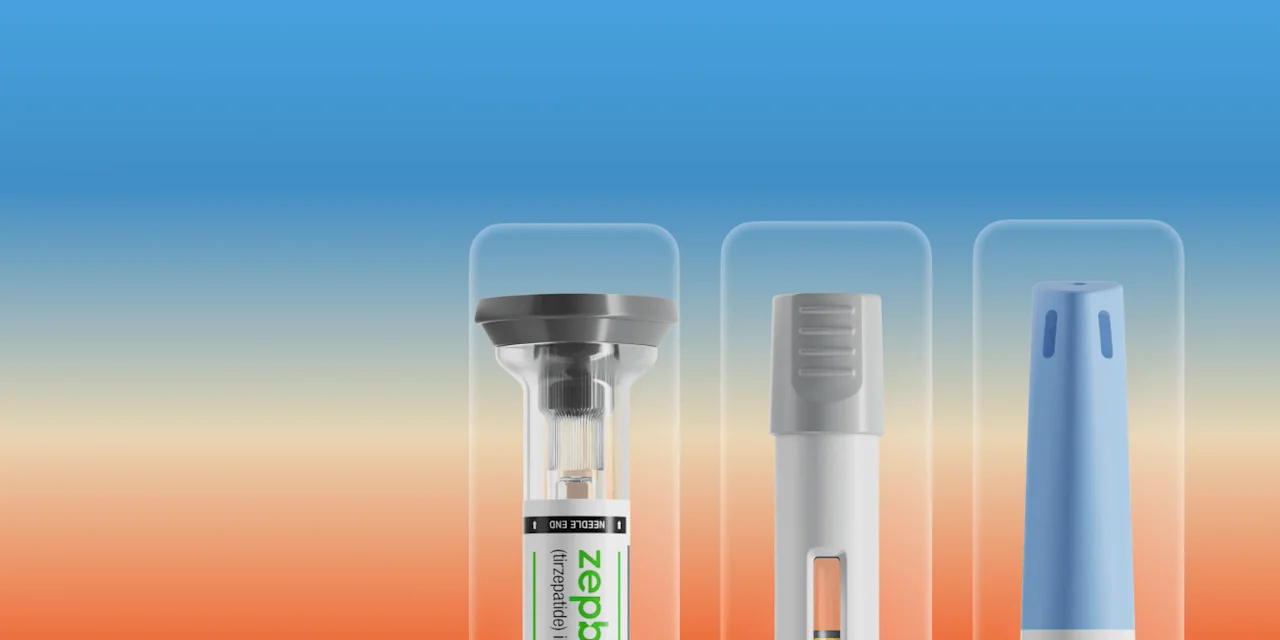Key takeaways
Losing 30 pounds in 3 months is an aggressive goal, and while technically possible, it’s probably not safe or achievable for most people.
A healthier, sustainable approach focuses on losing 1–2 pounds per week, through a combination of a lower-calorie but nutritious diet, regular exercise and hydration, stress management, and good sleep.
Setting realistic goals and adjusting your plan over time is key to success when it comes to losing weight and keeping it off.
Here's what we'll cover
Here's what we'll cover
Here's what we'll cover
Key takeaways
Losing 30 pounds in 3 months is an aggressive goal, and while technically possible, it’s probably not safe or achievable for most people.
A healthier, sustainable approach focuses on losing 1–2 pounds per week, through a combination of a lower-calorie but nutritious diet, regular exercise and hydration, stress management, and good sleep.
Setting realistic goals and adjusting your plan over time is key to success when it comes to losing weight and keeping it off.
Many people want quick weight loss results, whether it’s to feel more confident for an upcoming event or improve their health. These inquiring minds likely want to know: Can you lose 30 pounds in 3 months? And if so, how?
On paper, 30 pounds in 90 days may sound doable. It breaks down to about 2.5 pounds per week. But here’s the catch: Most experts recommend a safer, steadier pace of 1–2 pounds per week (at most, that’s about 26 pounds in three months). Lose weight faster and you could raise your risk of muscle loss, rebound weight gain, and even depression.
So, losing 30 pounds in 3 months may not be realistic, let alone safe, for most people. But losing 26 pounds in three months is nothing to sniff at. And even if you don’t hit that goal, building healthy, sustainable habits over this time period can set you up for long-term weight loss success.
So, what does it really take to lose 30 pounds in 90 days? Below, we’ll walk through eight key steps for weight loss, from setting your goals and calorie deficit to balancing your diet, exercise, stress, and sleep.
Step 1: Set clear, achievable goals
The first step in any weight loss plan is goal setting. If you want to lose 30 pounds in 3 months, you’ve definitely got a clear goal. But it may not be achievable, given that it’s safer to lose 1–2 pounds per week.
Regardless, whether you’re dead-set on 30 pounds in 3 months or okay with pushing it out to say, four months, it’s important to be specific with your weight loss goals. That goes beyond the number on the scale to include how you’ll achieve that goal.
How will you change your eating habits? What will your exercise routine look like?
Getting granular with your answers will help you create a plan — and stick to it. For example, “I will exercise four days per week and cook dinner at home five nights per week to lose 30 pounds in 3 months.”
Keep in mind that setting smaller goals, such as losing 5 pounds, can help you build momentum, says Claudia Hleap-Knight, RD, CDCES.
“The bigger your goal, the more overwhelming it can become, and easier to discount the small changes on the scale,” she says.
Instead, she recommends setting small goals, achieving them, and then creating new goals to work toward.
Before committing, ask yourself: Am I ready for the changes this goal requires? This weight loss readiness check-in helps you prepare mentally and practically for the journey ahead.
Step 2: Calculate your calorie needs and create a safe deficit
At its core, weight loss comes down to a fairly basic formula: burn more calories than you consume. You can get a rough idea of how many calories you’re eating daily by looking up the nutrition information on food packaging, restaurant menus, and more.
From there, you want to create a calorie deficit, which is achieved by eating fewer calories than you’re currently burning. An online calorie calculator (such as the one below) can help you calculate your calorie deficit.
These calculators estimate how many calories you burn daily (your total daily energy expenditure, or TDEE) based on your height, weight, and activity level. Then, they tell you the number of calories you should aim to eat per day to achieve your goal weight.
The difference between your previous calorie intake and the suggested one is your calorie deficit. Some people may need to eat 500–1,000 fewer calories per day to reach their weight loss goals, says Paul Jaeckel, RD, CDN.
But, according to Jaeckle, there’s nuance because you don’t want to push your intake below the minimum safe levels of 1,200 calories per day for women and 1,500 for men.
Remember, too, that those minimums are general guidelines. Your optimal calorie level depends on individual factors, such as your:
Age
Activity level
Body size
Body composition
For some people, even a lower deficit of 200 calories daily can be a good number to start with, Hleap-Knight says.
If you’d like help calculating a safe calorie deficit, consult a healthcare provider or a registered dietitian.
Find your recommended calorie deficit
A calorie deficit happens when you consume fewer calories than you burn. It’s key to weight loss and can help guide your nutrition strategy. Use the tool below to estimate how many calories you need each day to reach your weight loss goals safely.
Maintain your current weight
----
cal daily
Lose one pound per week
----
cal daily
Time to achieve your __ goal weight
----
Weeks
This calculator gives a general estimate and isn't medical advice. Everyone's body is different. For guidance that’s tailored to your health and goals, it’s always best to speak with a healthcare provider.
Step 3: Build a balanced meal plan
Next, it’s time to focus on how to get the most nutritional bang for your buck while meeting your calorie deficit.
Both Jaeckel and Hleap-Knight agree that your meal plan should include three key ingredients:
Lean proteins, such as lentils, legumes, beans, chicken, turkey, and fish
Carbohydrates, such as fiber-rich fruits, veggies, and whole grains
Healthy fats, such as olive oil, nuts, and avocados
“Prioritizing protein, fiber, and diversity in your diet helps you stay full and satisfied while meeting your calorie needs,” Hleap-Knight says.
Studies show that simply making your meals more colorful can lead to incorporating more fruits and vegetables — and finding them tastier as well.
Beyond going for the rainbow, here are a few more tips for helping you adjust to your new diet and lose (close to) 30 pounds in 3 months:
Remember portion control. You can use visual cues like your hand to avoid overeating. Think: proteins should fit the size of your palm, carbs should fit your fist, and fats should fit your thumb.
Eat regular meals vs. skipping breakfast. More than one study has linked skipping breakfast to poorer diet quality, increased sugar intake, and obesity. Additionally, many weight loss studies are conducted after a standardized breakfast, further emphasizing the importance of a healthy meal to start the day.
Practice mindful eating. Mindful eating encourages eating without distractions and paying attention to how the food tastes, looks, and feels. It can help you better tune in to your hunger cues and slow down while eating, which can significantly reduce how much food you eat.
A note about sweet treats: Processed foods, refined carbohydrates, and sugary sodas are all linked to obesity. In an ideal world, you’d cut these out completely.
In the real world, however, limitation is a better goal than outright restriction, Jaeckel says. “When you reject and avoid a lot of foods, it can lead to binge eating.”
Step 4: Stay hydrated
Staying hydrated is important to overall health, but it plays an effective role in weight loss, too. Studies show that drinking water or replacing diet beverages with water can lead to significant weight loss, sometimes as much as 19 pounds in six months or as much as 4 pounds in three months!
Effective hydration tactics include:
Carrying a reusable water bottle with you
Setting reminders on your phone to drink water throughout the day (say, a small amount every hour)
Drinking a glass of water first thing in the morning
So, how much water should you drink to lose weight? At least 8 cups daily is a good place to start. But research shows that for some people, drinking an additional 6 cups daily — ideally, 2 cups before each meal — could modestly enhance weight loss by promoting fullness and decreasing calorie intake.
To lose weight in three months:
Swap out soda and other sweetened beverages for water, sparkling water, or unsweetened tea
Liven up a glass of regular H20 with a slice of lime or your favorite fruit
Step 5: Combine cardio and strength training
Any exercise is good exercise when it comes to weight loss, Hleap-Knight says. “[But] strength training is more effective at building muscle, which is important for increasing metabolism.”
The key is creating (and following!) an exercise routine that combines cardio and strength training exercises.
Cardio (aka aerobic) exercise burns calories and improves heart health.
Aim for at least 150–300 minutes of moderate-intensity exercise per week.
This can be done daily (20–40 minutes per day) or through longer workouts on fewer days.
Try brisk walking, jogging, biking, swimming, or dance classes.
Strength training builds and preserves muscle, which helps your metabolism burn calories even faster.
Aim for three sessions per week and target all major muscle groups.
Try full-body workouts like yoga or pilates as well as specific bodyweight exercises like squats, push-ups, and planks.
Did we mention that exercise can also have a mild appetite-suppressing effect? That’s one more way it can help you approach losing 30 pounds in 3 months (or four…or five…).
Step 6: Stay active (outside the gym)
Remember that TDEE (total daily energy expenditure) we mentioned earlier? It includes all the calorie-burning activities you do throughout the day, from walking around your house to going to the gym.
To uplevel your weight loss results in three months, find new ways to be active beyond your workouts. For example, you can:
Choose the stairs over the escalator
Walk 10,000 steps per day
Stretch while watching TV
Play music and dance while cleaning your house
Take up a hobby that incorporates movement
Step 7: Manage stress and prioritize good sleep
While diet arguably plays the largest role in weight loss, sleep and stress are also important.
“If you’re not sleeping, you won’t have energy to work out,” Jaeckel says. “If you’re stressed, your hormones are out of whack and you can’t comfortably follow your diet.”
Let’s take a look at the research:
Chronic stress can increase cortisol. This, in turn, can lead your body to hold onto fat, crave higher-calorie foods, and engage in emotional eating.
Chronic lack of sleep can mess with your appetite hormone levels. This can make you hungrier, less satisfied, and too tired to work out. As a result, people who don’t sleep well tend to be more likely to gain weight.
There’s good news, though. Studies show that getting a good handle on your sleep and stress levels can support weight loss. Stress management techniques in children and adolescents showed positive effects even in periods shorter than three months!
The general recommendation is to aim for 7–9 hours of quality sleep per night.
These techniques for improving sleep and stress can help:
Deep breathing exercises
Guided visualization or meditation
Following a consistent, calming bedtime routine (sans electronics)
Gentle yoga, stretching, or tai chi
Step 8: Track progress and adjust
Tracking your goals can keep you accountable and motivated.
Studies show that when people more consistently track their weight loss or calorie intake, they tend to lose more weight.
Some ways you can track your weight loss progress include:
Weighing yourself
Taking body measurements
Snapping a mirror selfie
Using apps or journals to log your meals or workouts
How often you track your progress (daily, weekly, monthly) is up to you. The important part is to be consistent.
Also, don’t forget to celebrate your wins. Hleap-Knight encourages noting non-scale victories, such as exciting changes to how you feel, your energy levels, exercise endurance, strength, and sleep quality.
Noticing these positive changes can help you maintain motivation when the going gets tough (hey, it happens), so you can get closer to your goal weight.
When to see a healthcare provider
The steps we’ve outlined above are research-backed to help you lose weight fast while staying healthy. Having said that, sometimes people need additional support.
So, how do you know if you’re one of those people? See if any of the following sound familiar:
You’re not losing weight even with diet and exercise changes
You have a chronic health condition like diabetes or polycystic ovary syndrome (PCOS)
You feel stressed, depressed, or anxious
You feel fatigued or sluggish
You’re having trouble sleeping
If any of the above resonated with you, reach out to a healthcare provider. They can help you treat a possibly undiagnosed condition, recommend weight loss medication in some cases, or refer you to a dietitian or nutritionist.
Bottom line
Trying to lose 30 pounds in 3 months is ambitious, to say the least. For most people, it can require a serious calorie deficit, which may not be safe or sustainable long-term. Still, by focusing on healthy habits, you can make meaningful progress toward your goals, whether you lose 10, 20, or even 30 pounds in 90 days.
Here’s what to remember:
Set realistic goals. Aim for 1–2 pounds per week, but know that progress varies from person to person.
Create a safe calorie deficit. Work with your healthcare provider, a dietician, or use your TDEE to guide your new daily caloric intake, but avoid going below 1,200–1,500 calories per day.
Eat nutrient-dense meals. Prioritize protein, fiber, and healthy fats that boost fullness while limiting the processed foods that leave you wanting more.
Stay active with cardio and strength training. This combo has been shown to burn calories while preserving muscle mass and optimizing your metabolism.
Prioritize taking care of yourself. Managing your stress, getting a good night’s sleep, and celebrating your wins along the way can make it easier to stick to your new habits.
Frequently asked questions (FAQs)
How quickly can I safely lose 30 pounds?
Most experts recommend losing 1–2 pounds per week. At that pace, losing 30 pounds could take around 4–7 months. While faster loss is theoretically possible, it’s not safe for most people and comes with higher risks of nutrient deficiencies, muscle loss, and rebound weight gain.
How much should I walk a day to lose 30 lbs in 3 months?
Walking is a great way to burn calories and lose weight. Aiming for 10,000 steps per day (about 5 miles) can contribute significantly to weight loss, especially when paired with diet and exercise. For the best results, about 3,500 of those steps should come from dedicated exercise that’s more intense than simply walking at your regular pace, such as jogging, dancing, or speed walking.
How many calories should I cut each day to lose 30 pounds in 3 months?
Generally, experts agree that cutting approximately 500–1,000 calories per day is safe for most people with obesity and leads to a weight loss of about 1–2 pounds per week. For a specific number based on your body weight, activity levels, and goals, use a calorie calculator or consult a healthcare professional, such as a dietitian.
Can I lose 30 lbs if I have a medical condition?
Potentially, but results may vary from person to person. Medical conditions like hypothyroidism, PCOS, or diabetes can affect your metabolism and body composition, leading to slower weight loss. Always check with your healthcare provider before starting an aggressive weight loss plan.
How do I keep the weight off after 3 months?
Long-term success depends on maintaining the habits that helped you lose the weight during the first 3 months. To keep the weight off after 3 months, continue to:
Exercise
Eat balanced meals
Celebrate your wins
Avoid extreme diets
Sustainable weight loss comes from sustainable lifestyle changes.
DISCLAIMER
If you have any medical questions or concerns, please talk to your healthcare provider. The articles on Health Guide are underpinned by peer-reviewed research and information drawn from medical societies and governmental agencies. However, they are not a substitute for professional medical advice, diagnosis, or treatment.
References
Aristizabal, J. C., Freidenreich, D. J., Volk, B. M., et al. (2015). Effect of resistance training on resting metabolic rate and its estimation by a dual-energy X-ray absorptiometry metabolic map. European Journal of Cinical Nutrition, 69(7), 831–836. doi:10.1038/ejcn.2014.216. Retrieved from https://www.nature.com/articles/ejcn2014216
Ashtary-Larky, D., Ghanavati, M., Lamuchi-Deli, N., et al. (2017). Rapid Weight Loss vs. Slow Weight Loss: Which is More Effective on Body Composition and Metabolic Risk Factors?. International Journal of Endocrinology and Metabolism, 15(3), e13249. doi:10.5812/ijem.13249. Retrieved from https://pmc.ncbi.nlm.nih.gov/articles/PMC5702468/
Bracamontes-Castelo, G., Bacardí-Gascón, M., & Jiménez Cruz, A. (2019). Effect of water consumption on weight loss: a systematic review. Nutricion Hospitalaria, 36(6), 1424–1429. doi:10.20960/nh.02746. Retrieved from https://pubmed.ncbi.nlm.nih.gov/31657610/
Centers for Disease Control & Prevention (CDC). (2025). Steps for Losing Weight. Retrieved from https://www.cdc.gov/healthy-weight-growth/losing-weight/
Cox, C. E. (2017). Role of Physical Activity for Weight Loss and Weight Maintenance. Diabetes Spectrum: A Publication of the American Diabetes Association, 30(3), 157–160. doi:10.2337/ds17-0013. Retrieved from https://www.ncbi.nlm.nih.gov/pmc/articles/PMC5556592/
Creasy, S. A., Lang, W., Tate, D. F., et al. (2018). Pattern of Daily Steps is Associated with Weight Loss: Secondary Analysis from the Step-Up Randomized Trial. Obesity (Silver Spring, Md.), 26(6), 977–984. doi:10.1002/oby.22171. Retrieved from https://pmc.ncbi.nlm.nih.gov/articles/PMC5970037/
Dabas, J., Shunmukha Priya, S., Alawani, A., et al. (2024). What could be the reasons for not losing weight even after following a weight loss program?. Journal of Health, Population, and Nutrition, 43(1), 37. doi:10.1186/s41043-024-00516-4. Retrieved from https://pmc.ncbi.nlm.nih.gov/articles/PMC10908186/
Dorling, J., Broom, D. R., Burns, S. F., et al. (2018). Acute and Chronic Effects of Exercise on Appetite, Energy Intake, and Appetite-Related Hormones: The Modulating Effect of Adiposity, Sex, and Habitual Physical Activity. Nutrients, 10(9), 1140. doi:10.3390/nu10091140. Retrieved from https://pmc.ncbi.nlm.nih.gov/articles/PMC6164815/
Fanelli, S., Walls, C., & Taylor, C. (2021). Skipping breakfast is associated with nutrient gaps and poorer diet quality among adults in the United States. Proceedings of the Nutrition Society, 80(OCE1). doi:10.1017/s0029665121000495. Retrieved from https://www.cambridge.org/core/journals/proceedings-of-the-nutrition-society/article/skipping-breakfast-is-associated-with-nutrient-gaps-and-poorer-diet-quality-among-adults-in-the-united-states/C7943690D97E913FA19B936BFBDB0F2A
Farhana, A. & Rehman, A. (2023). Metabolic consequences of weight reduction. StatPearls. Retrieved from https://www.ncbi.nlm.nih.gov/books/NBK572145/
Hawton, K., Ferriday, D., Rogers, P., et al. (2018). Slow Down: Behavioural and Physiological Effects of Reducing Eating Rate. Nutrients, 11(1), 50. doi:10.3390/nu11010050. Retrieved from https://www.ncbi.nlm.nih.gov/pmc/articles/PMC6357517/
Joshi, S. & Mohan, V. (2018). Pros & cons of some popular extreme weight-loss diets. The Indian Journal of Medical Research, 148(5), 642–647. doi:10.4103/ijmr.IJMR_1793_18. Retrieved from https://www.ncbi.nlm.nih.gov/pmc/articles/PMC6366252/
Juul, F., Martinez-Steele, E., Parekh, N., et al. (2018). Ultra-processed food consumption and excess weight among US adults. The British Journal of Nutrition, 120(1), 90–100. doi:10.1017/S0007114518001046. Retrieved from https://www.cambridge.org/core/journals/british-journal-of-nutrition/article/ultraprocessed-food-consumption-and-excess-weight-among-us-adults/5D2D713B3A85F5C94B0C98A1F224D04A
Kim, J. Y. (2021). Optimal Diet Strategies for Weight Loss and Weight Loss Maintenance. Journal of Obesity & Metabolic Syndrome, 30(1), 20–31. doi:10.7570/jomes20065. Retrieved from https://www.ncbi.nlm.nih.gov/pmc/articles/PMC8017325/
Kline, C. E., Chasens, E. R., Bizhanova, Z., et al. (2021). The association between sleep health and weight change during a 12-month behavioral weight loss intervention. International Journal of Obesity (2005), 45(3), 639–649. doi:10.1038/s41366-020-00728-8. Retrieved from https://www.ncbi.nlm.nih.gov/pmc/articles/PMC7914147/
Koliaki, C., Spinos, T., Spinou, Μ., et al. (2018). Defining the Optimal Dietary Approach for Safe, Effective and Sustainable Weight Loss in Overweight and Obese Adults. Healthcare (Basel, Switzerland), 6(3), 73. doi:10.3390/healthcare6030073. Retrieved from https://www.ncbi.nlm.nih.gov/pmc/articles/PMC6163457/
König, L. M. & Renner, B. (2019). Boosting healthy food choices by meal colour variety: results from two experiments and a just-in-time Ecological Momentary Intervention. BMC Public Health, 19(1), 975. doi:10.1186/s12889-019-7306-z. Retrieved from https://www.ncbi.nlm.nih.gov/pmc/articles/PMC6647103/
Luger, M., Lafontan, M., Bes-Rastrollo, M., et al. (2017). Sugar-Sweetened Beverages and Weight Gain in Children and Adults: A Systematic Review from 2013 to 2015 and a Comparison with Previous Studies. Obesity Facts, 10(6), 674–693. doi:10.1159/000484566. Retrieved from https://pmc.ncbi.nlm.nih.gov/articles/PMC5836186/
Ma, X., Chen, Q., Pu, Y., et al. (2020). Skipping breakfast is associated with overweight and obesity: A systematic review and meta-analysis. Obesity Research & Clinical Practice, 14(1), 1–8. doi:10.1016/j.orcp.2019.12.002. Retrieved from https://pubmed.ncbi.nlm.nih.gov/31918985/
Pourzanjani, A., Quisel, T., & Foschini, L. (2016). Adherent Use of Digital Health Trackers Is Associated with Weight Loss. PloS One, 11(4), e0152504. doi:10.1371/journal.pone.0152504. Retrieved from https://www.ncbi.nlm.nih.gov/pmc/articles/PMC4822791/
Sánchez López de Nava, A., & Raja, A. (2022). Physiology, Metabolism. StatPearls. Retrieved from https://www.ncbi.nlm.nih.gov/books/NBK546690/
Sarwan, G., Daley, S. F., & Rehman, A. (2024). Management of Weight Loss Plateau. StatPearls. Retrieved from https://www.ncbi.nlm.nih.gov/books/NBK576400/
Sharafi, M., Alamdari, N., Wilson, M., et al. (2018). Effect of a High-Protein, High-Fiber Beverage Preload on Subjective Appetite Ratings and Subsequent Ad Libitum Energy Intake in Overweight Men and Women: A Randomized, Double-Blind Placebo-Controlled, Crossover Study. Current Developments in Nutrition, 2(6), nzy022. doi:10.1093/cdn/nzy022. Retrieved from https://pmc.ncbi.nlm.nih.gov/articles/PMC6016687/
Stavrou, S., Nicolaides, N. C., Papageorgiou, I., et al. (2016). The effectiveness of a stress-management intervention program in the management of overweight and obesity in childhood and adolescence. Journal of Molecular Biochemistry, 5(2), 63–70. Retrieved from https://www.ncbi.nlm.nih.gov/pmc/articles/PMC4996635/
Swift, D. L., Johannsen, N. M., Lavie, C. J., et al. (2014). The role of exercise and physical activity in weight loss and maintenance. Progress in Cardiovascular Diseases, 56(4), 441–447. doi:10.1016/j.pcad.2013.09.012. Retrieved from https://www.ncbi.nlm.nih.gov/pmc/articles/PMC3925973/
Tapper, K. (2022). Mindful eating: What we know so far. Nursing in Breastfeeding. doi: 10.1111/nbu.12559. Retrieved from https://onlinelibrary.wiley.com/doi/10.1111/nbu.12559
Tomiyama, A. J. (2019). Stress and Obesity. Annual Review of Psychology, 70, 703–718. doi:10.1146/annurev-psych-010418-102936. Retrieved from https://www.annualreviews.org/doi/10.1146/annurev-psych-010418-102936
US Department of Agriculture and US Department of Health and Human Services.(USDA). (2020). Dietary Guidelines for Americans, 2020–2025. Retrieved from https://www.dietaryguidelines.gov/sites/default/files/2020-12/Dietary_Guidelines_for_Americans_2020-2025.pdf
Vij, V. A., & Joshi, A. S. (2014). Effect of excessive water intake on body weight, body mass index, body fat, and appetite of overweight female participants. Journal of Natural Science, Biology, and Medicine, 5(2), 340–344. doi:10.4103/0976-9668.136180. Retrieved from https://pmc.ncbi.nlm.nih.gov/articles/PMC4121911/
von Loeffelholz, C., & Birkenfeld, A. L. (2022). Non-Exercise Activity Thermogenesis in Human Energy Homeostasis. Endotext. Retrieved from https://www.ncbi.nlm.nih.gov/books/NBK279077/
Xu, H., Zhang, Z., & Wang, Y. (2025). Weight loss methods and risk of depression: Evidence from the NHANES 2005-2018 cohort. Journal of Affective Disorders. doi:10.1016/j.jad.2025.03.199. Retrieved from https://www.sciencedirect.com/science/article/abs/pii/S016503272500549X













